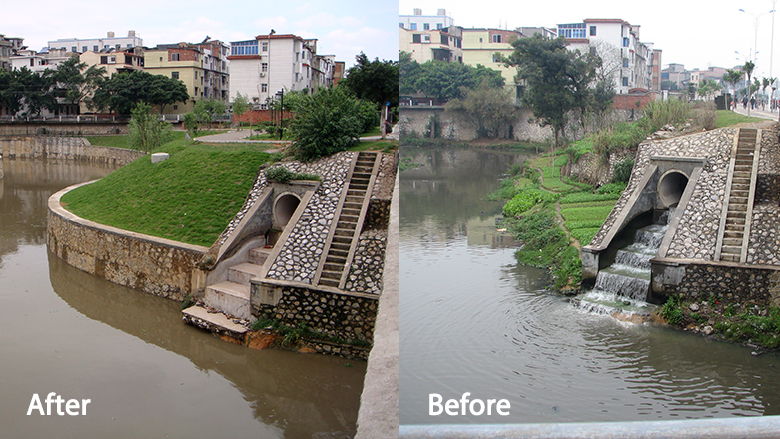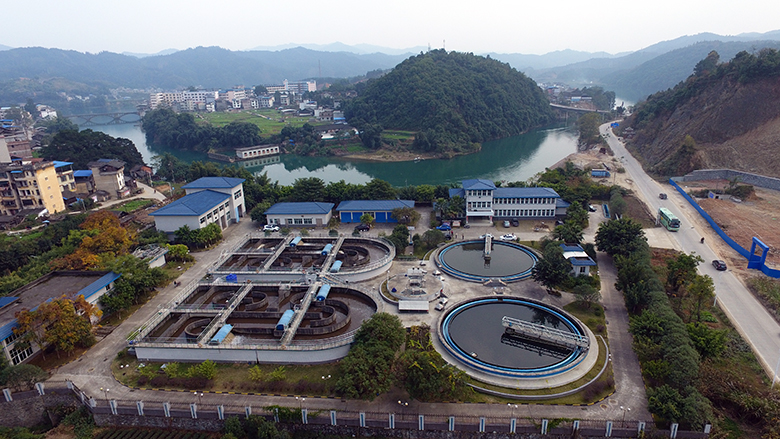Results
The first Liuzhou Environment Management Project was implemented in 2005-2011 and achieved the following results:
- Wastewater treatment capacity increased from 100,000 to 500,000 m3 per day and treatment rate from 15% to 75% in the central urban areas of Liuzhou, thanks to the four wastewater treatment plants and associated pumping stations and sewerage networks built under the project. A total of 1.2 million people benefited from better wastewater services.
- Dredging and rehabilitation of Zhu’e Creek, a major inland river in Liuzhou, sewage interception and treatment, and landscaping on creek banks greatly improved the environment along the creek.

- A total of 42 public toilets and 30 portable toilets constructed under the project provided convenience to the residents and visitors alike.
- The new solid waste transfer station processes about half of the solid waste generated in the city.
- The Liuzhou Municipal Wastewater Treatment Company was established to take over wastewater management from the local government and was given the right to collect wastewater tariffs, setting an important milestone in the sectoral institutional reform.
- The Municipal Environmental Protection Bureau’s capacity was strengthened through implementation of the industrial pollution control component. It has been equipped with high-tech, online monitoring instruments and is executing the discharge permit and licensing system.
The second Liuzhou Environment Management Project was implemented from 2011-2018 and achieved the following results:
- Wastewater treatment rate reached up to 75% in the urban district and over 85% in the four project counties, thanks to the construction of six new wastewater treatment plants and sewerage systems. An additional 1.8 million people benefited from improved wastewater services.
- Dewatered sludge from the wastewater treatment plants is used for production of cement and bricks, serving as a model for green treatment and resource utilization of municipal sludge.
- The capacity of Liuzhou Municipal Wastewater Treatment Company was further strengthened through staff training on wastewater facility operation, waste and storm water pipeline maintenance, water quality monitoring and asset management, as well as managerial skills on construction and project management, procurement processes and financial management. An MIS/GIS was installed for the company to monitor and manage the assets built under the project. The operational costs are financed by revenues collected from wastewater tariffs combined with subsidies provided by the local government, ensuring the company’s financial sustainability.
- Liuzhou has been awarded “China Habitat Environment Prize”, “National Garden City” and “Top 20 Cities for Energy Saving and Emission Reduction” since 2009.
Bank Group Contribution
The World Bank financed the first and second Liuzhou Environment Management Project with two loans of US$100 million and US$150 million respectively from the International Bank for Reconstruction and Development (IBRD). In addition, the Bank team brought expertise and experience from other urban environment projects in China as well as from wastewater and sanitation programs around the world. The Bank also enjoyed a strong comparative advantage in advising on public utility sector policies and reforms. During project preparation, the Bank created a tailored financial model to help wastewater plants better understand the composition of their costs and identify ways to reduce such costs. On the basis of this model, the Liuzhou Municipal Wastewater Treatment Company developed its own operational expenditure (OPEX) model. The Bank also provided technical assistance in the design of the institutional structure of the Liuzhou Municipal Wastewater Treatment Company and offered competency training to build up its staff capacity.
Partners
Liuzhou Municipal Government invested about US$238 million in the two projects and provided consistent support during project implementation. Relevant departments actively fulfilled their managing functions and proactively assisted in problem-solving to ensure that the project progressed smoothly and effectively.
Moving Forward
Liuzhou Municipal Wastewater Treatment Company is now responsible for operating and maintaining Liuzhou’s wastewater assets. The company is well staffed, and its operation and maintenance costs are covered by a combination of wastewater tariff revenues and government subsidies.
Water quality monitoring indicators developed under the project have been adopted by the government. The water quality of the Liujiang River downstream area of Liuzhou Municipality has remained safe for drinking and fishing.
Beneficiaries
The World Bank-funded project has reduced pollutants discharged into the Liujiang River and improved the water environment in Liuzhou. The project has reused the sludge from the wastewater treatment plants, which has reduced further pollution and set a good example in China. Construction of public toilets and solid waste transfer stations have also improved the living environment for the residents in Liuzhou. —— Wu Wei, Mayor of Liuzhou


